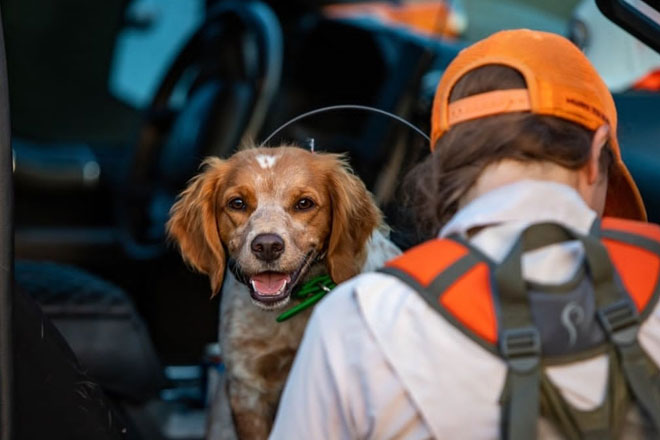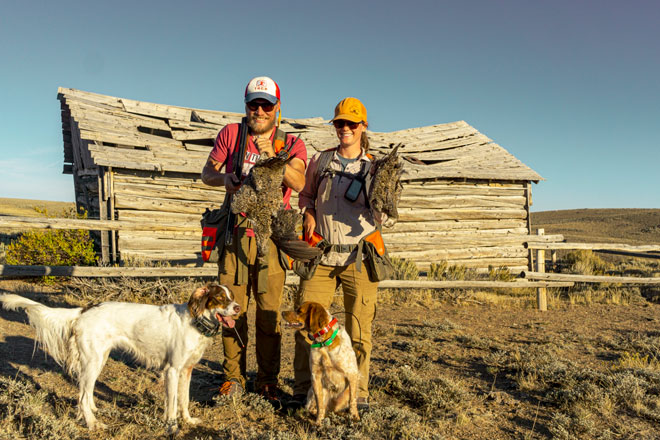Photo by Zach Hoheisel
Raising a young bird dog, one discovery and one bit of help at a time
By Liz Lynch
“Penjeacu (pen-hay-ah-cu) Pueblo,” announces a nondescript, chocolate brown sign somewhere in New Mexico. The sign goes on to remind any wayward visitors that they’re stepping foot into an ancient village that’s believed by some to still be inhabited by the spirits of the Piro people, who constructed the cobble walls I’m nimbly sidestepping, anxious about avoiding harm. Romantic visions of sharing this place with its past residents by way of the sandy soils and quail tracks pressed gently into them have my eyes glazing over— until a shin-high blur of red roan goes shooting by and nearly tips me over.
Indie. Indie! Indiana! I hiss, trying to not raise my voice too much, lest we flush birds or spirits from the desert scrub. Demanding a four-month-old Breton abide by the laws of the check cord and good archaeological site etiquette is a fool’s errand; she’s hellbent on doing everything she shouldn’t. How appropriate that she’s named after the man who was, arguably, the absolute worst archaeologist ever, but nonetheless an accomplished appreciator of good dogs and wild places.
Indie is my first bird dog. I quickly learned that a French Brittany is not unlike most mustelids: yes, adorable, but more importantly, they are a tremendous amount of vim and vigor in a tiny body determined to punch above its weight class when on the hunt. I feel every bit as smitten with her as I feel in over my waders. Not only is she new to me, but I’m relatively new to upland hunting. What are we even doing here?
 Photo by Zach Hoheisel
Photo by Zach Hoheisel
In theory, we’re down here looking for Gambel’s and perhaps scaled quail. In reality, we’re encountering a generous quantity of doves we can’t shoot and occasional jackrabbits who seem to outsize my dog. My fiance’s setter charges out ahead of our slower moving pack, deftly bending to-and-fro with her head high.
For everything she does that looks like a living edition of a George Bird Evans themed illustration, stylish and bright, my “sporting potato” plays the part of the cartoonish little sister. She wants to sniff everything in front of her, she has no interest in wearing her protective equipment, and when we encounter birds, it feels as if I’ve ended up with a flusher rather than a pointer.
Quietly, I begin to panic: have I found a way to ruin this dog within a month of getting her? Do I have what it takes to train her? What if she becomes more attached to my partner, Jared, than me? What if I make her gun shy? What if she actually hates hunting?
Nothing, it seems, goes as expected with a first bird dog.
In the following year, I was forced to learn the lesson that it takes a village to raise a puppy. Going into the purchase, I was convinced that I would DIY everything: training in the home, training in the field, feeding, keeping her occupied and safe during the day, doctoring. I’d read up on every training method I could. I was also convinced that, somehow, being in the field behind a setter for a couple of months would mean I’d end up with the rangiest, most intensely pointing Breton the western United States had ever seen.
Dear reader, if you’re on your second, fifth, or fifteenth bird dog, I know you’re chuckling. With a one-eyed Gambel’s quail in the bag and little else to show for what felt like working four times as hard for a quarter of the dog work, I was standing on the precipice of what every novice bird dog owner has to learn on their own: nothing will go the way you hope or expect it to with a puppy.
I read some books and articles, and found they contradicted each other so much that I needed a trainer as much as my dog did. Fundamental obedience training happened at home, but getting a rangier dog who would fetch without fail took the help of trainers at Cove Mountain and Sage Spring Kennels across two months per year.
Indiana spent far more of her summertime than expected with Jared and Rhiza because my fieldwork took me away from home for days at a time, every week, for months on end. Friends came out of the woodwork, online and in person, to provide tips for specific training issues and direct me to the best learning resources. I could not have been more off-base in thinking any of this was going to occur without a community of wise, wonderful bird hunters and dog handlers uplifting me.
 Photo by Jared Oakleaf
Photo by Jared Oakleaf
However, my panic was proven wrong, too, time and time again. It also turned out to be fitting that my dog was named after a professor, because after a first season full of flubs, in her second season, Indiana taught me more about bird hunting and self-confidence than I could have ever hoped to figure out on my own.
At the start of her season, she was pointing male sage grouse her size fearlessly; mid-season, going to pick up a rooster pheasant with enough life left in him to lead her on a wild bird chase of the highest order; end of season, finding her own coveys of chukar at 400 yards out.
Her love of her job was undeniable and infectious; I’m not sure I’ve ever smiled so much afield. The benchmarks of what constituted success shifted seismically: I felt more of an obligation to improve my wingshooting to better honor Indie’s efforts, and yet, was also every bit as happy to walk without a gun if it meant I got to more deeply appreciate the dog work unfolding before me. The less she doubted herself, the less I doubted myself. We grew together.
If you’re standing on that same precipice I was a year and a half ago, I can’t recommend it enough: build your village — stone by stone, track by track, flub by flub — and take the plunge.
Liz Lynch is an archaeologist, novice bird hunter, Wyoming BHA board member, Sporting Lead-Free ambassador, and food geek living in Pinedale, Wyoming. She spends as much time as she can burning boot leather in the hills of Wyoming’s forests and sage steppe with her better half, Jared Oakleaf; her French Brittany, Indiana, and Jared’s English setter, Rhiza.
This story originally appeared in the 2023 Summer Issue of the Quail Forever Journal. If you enjoyed it and would like to be the first to read more great upland content like this, become a Quail Forever member today!